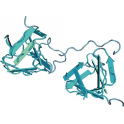
- Remove this product from my favorite's list.
- Add this product to my list of favorites.
Products
Newsletter
 |  |  |  |  |  |

Background:The p21-activated kinases (PAKs) belong to the group of serine/threonine protein kinases and are subdivided into two groups, PAK1-3 (group I) and PAK4-6 (group II), based on sequence similarities and an autoinhibitory domain which is present in group I, but not group II PAK. PAK7 (also known as PAK5), the latest PAK family member to be identified in 2002 has different properties from those of other members of the PAK family; for example, the Cdc42/Rac GTPase binds to PAK5 but does not regulate PAK7 kinase activity. However, CDC42, but not Rac, is able to activate the autophosphorylation of PAK7 in a GTP- dependent manner. All PAKs composed of an N-terminal regulatory domain and a highly conserved C-terminal catalytic domain. Group II PAKs do contain p21-binding domains (PBD) but are active in the absence of GTPases. Removal of the N terminus results in an increase in kinase activity for PAK7, suggesting that group II PAKs' kinase activity might also be modulated by intra- or intermolecular interactions. PAK7 has different effectors, depending on its localization. In the cytosol, PAK7 can activate the c-Jun N-terminal kinase (JNK) pathway. In mitochondria, it can activate cell survival signaling pathways by phosphorylating BAD on Ser-112, preventing the localization of BAD to the mitochondria and inhibits the apoptotic cascade. Furthermore, PAK7 is an inhibitor of MARK2, a kinase that has been shown to induce microtubule disruption by phosphorylating microtubule-associated proteins such as tau.
Recombinant human PAK7 (p21 activated protein kinase 7), serine threonine kinase, recombinant and active enzyme, N-terminally fused to GST-HIS6-Thrombin cleavage site
Theoretical MW : 110.660 kDa (fusion proteins)
Expression system: Baculovirus infected Sf9 cells
Purification: One-step affinity purification using GSH-agarose
Storage buffer: 50 mM Tris-HCl, pH 8.0; 100 mM NaCl, 5 mM DTT, 4 mM reduced glutathione, 20% glycerol
Protein concentration: 0.152 mg/ml (Bradford method using BSA as standard protein)
Method for determination of Km value & specific activity: Filter binding assay MSPH membrane
Specific activity : 18,000 pmol/mg min
Entrez Gene ID: 57144
UniProtKB: Q9P286
Ordering information: shipped on dry ice
Eswaran J1, Lee WH, Debreczeni JE, Filippakopoulos P, Turnbull A, Fedorov O, Deacon SW, Peterson JR, Knapp S. (2007) "Crystal Structures of the p21-activated kinases PAK4, PAK5, and PAK6 reveal catalytic domain plasticity of active group II PAKs."Structure. (2):201-13.
Pandey A1, Dan I, Kristiansen TZ, Watanabe NM, Voldby J, Kajikawa E, Khosravi-Far R, Blagoev B, Mann M. (2002) "Cloning and characterization of PAK5, a novel member of mammalian p21-activated kinase-II subfamily that is predominantly expressed in brain."Oncogene.;21(24):3939-48.
Fang ZP1, Jiang BG2, Gu XF3, Zhao B3, Ge RL2, Zhang FB1.(2014)"P21-activated kinase 5 plays essential roles in the proliferation and tumorigenicity of human hepatocellular carcinoma."Acta Pharmacol Sin. 35(1):82-8.
Recombinant human serine/threonine-protein kinase PAK1, 10µg - 465,00 €
Recombinant, human serine/threonine-protein kinase PAK2, 10µg - 465,00 €
Recombinant human Misshapen-like kinase 1 (MINK1), protein kinase domain, 10 µg - 465,00 €
Recombinant human Mammalian Sterile20-like kinase 1 (Mst1), 10 µg - 465,00 €
Recombinant human Mammalian STE20-like protein kinase 2 (MST2), 10 µg - 465,00 €
Recombinant human serine/threonine-protein kinase PAK3, 10 µg - 465,00 €
Welcome Login
Contact us
Follow us